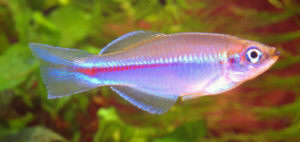Plataplochilus miltotaenia Lambert 1963

Plat.miltotaenia
Lambarené. Male.
Photo courtesy of Ed Pürzl.
| Meaning of Name |
|
||
| First Description |
|
||
| Size |
|
||
| Meristics |
|
||
| Karyotype |
|
||
| Sub-Genus |
|
||
| Group |
|
||
| Synonyms |
|
||
|
Populations
|
|
||
| Type Locality | |||
| Distribution | |||
| Habitat |
See the History section. Sympatric sp. include A.striatum. |
||
| Distinguishing Characteristics | |||
| Colour/Pattern Variability | Unknown. They are distributed over a fairly large area but few photos or reports exist to determine variability. Pürzl reported collecting in 1985 in a couple of points approx 60km apart but no differences could be observed. | ||
| History |
Probable first introduction to the hobby in 1976.
At this time it was found south of Lambaréné not far from
the type locality. |
||
| Breeding Notes |
Eggs are attached to plants etc by means of a
polar filament. Females lay only 2-3 eggs daily but the spawning season
can be lengthy. Incubation takes 15-18 days & the newly emerged
fry can swim immediately. Ed Pürzl reports them spawning in cracks
of roots & bark & coined the phrase 'fissure spawners'. This
is a similar method in Lamprichthys
in Lake Tanganyika. |
||
| Diameter of Egg | 1·6 mm 1·5 mm (Pürzl) |
||
| Remarks |
It should be noted that this sp. is found in fast flowing water which suggests high oxygen content & virtually zero disolved metabolic wastes so zero nitries & nitrates. Basically treat them as you would Tanganyikan cichlids & water change regularly. Even wild fish will accept dried foods so they are not too fussy on diet. Newly hatched Brine Shrimp are a favorite feed. Reference - BKA Newsletter No.338, November 1993. |

